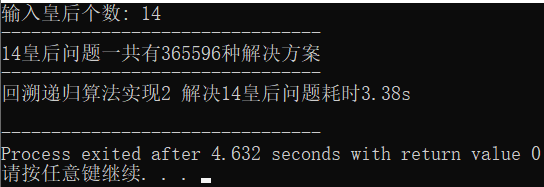运行结果

代码如下
1 #include <bits/stdc++.h> 2 using namespace std; 3 const int MAX = 1024; 4 const char *LINE32 = "--------------------------------"; 5 const bool PRINT_DETAILS = false; 6 long long n, cnt = 0;// n表示皇后数量,cnt表示方案数量 7 int vis[3][2*MAX+1]; 8 //v[0][]、v[1][]、v[2][]分别表示列、主对角线、副对角线是否存在皇后 9 // 为0时表示无皇后,非0则表示有,且v[0][4]=2表示第四列第二行存在皇后 10 11 void print() { 12 cout << LINE32 << endl; 13 cout << "第" << cnt << "个方案: " << endl; 14 for (int i = 1; i <= n; i++) { 15 if (i != 1) { 16 cout << ", "; 17 } 18 cout << "(" << vis[0][i] << "," << i << ")"; 19 } 20 cout << endl; 21 for (int i = 1; i <= n; i++) { 22 for (int j = 1; j <= n; j++) { 23 if (vis[0][j] != i) { 24 cout << 'x'; 25 } else { 26 cout << 'Q'; 27 } 28 } 29 cout << endl; 30 } 31 } 32 33 bool check(int row, int col) {// 检查是否可以在(row,col)这个坐标放置皇后 34 return !(vis[0][col] || vis[1][row-col+n] || vis[2][row+col]); 35 } 36 void place(int row) {// 在第row行上放置皇后 37 if (row > n) { 38 cnt++; 39 if (PRINT_DETAILS) { 40 print(); 41 } 42 } else { 43 for (int col = 1; col <= n; col++) { 44 if (check(row, col)) { 45 vis[0][col] = row; 46 vis[1][row-col+n] = vis[2][row+col] = 1; 47 place(row+1); 48 vis[0][col] = vis[1][row-col+n] = vis[2][row+col] = 0; 49 } 50 } 51 } 52 } 53 54 int main() { 55 // input 56 cout << "输入皇后个数: "; 57 cin >> n; 58 // compute 59 clock_t begin = clock(); 60 place(1); 61 clock_t end = clock(); 62 // output 63 cout << LINE32 << endl; 64 cout << n << "皇后问题一共有" << cnt << "种解决方案" << endl; 65 cout << LINE32 << endl; 66 cout << "回溯递归算法实现2 解决" << n << "皇后问题耗时" << /*end-begin << "打点" <<*/(double)(end-begin)/CLOCKS_PER_SEC << "s" << endl; 67 return 0; 68 } 69 // 14 3~5s
与回溯递归算法实现1对比
回溯递归算法实现1运行情况

回溯递归算法实现2运行情况

可以看到,实现1运行时间大约为实现2的三倍,不难看出原因:实现1空间效率虽然高,但所带来的影响是在check方法判断时要进行循环;而实现2使用了更多的空间可以直接判断位置是否符合要求。